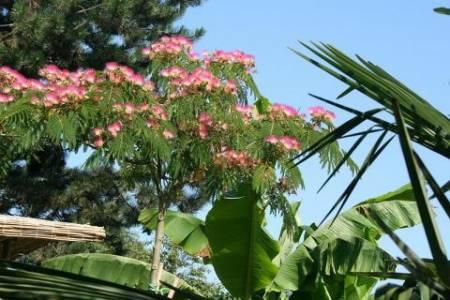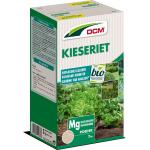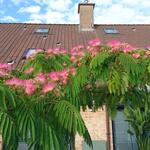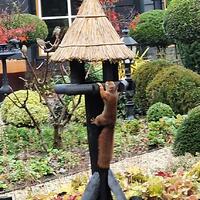 Nieuw
Nieuw 0
0Mijn Albizia Julibrissin Rosea krijgt gele bladeren
▼ Ga naar meest recente reactie
Ik eerder deze week al een bericht op het forum gezet, maar hoop nu in het weekend op wat meer respons, ook geef ik wat meer info over de stand en plaats van het boompje, dit naar aanleiding van de reacties van Danny en Peter.
Ik heb me net ingeschreven op dit forum en heb nog niet veel ervaring met dit soort exotische planten voor in de tuin.
Ik heb het boompje half mei gekocht en in de volle grond in de tuin gepoot.
Hij staat in de volle zon en tamelijk beschut.
De grond is zandrijke grond, wat goed schijnt te zijn voor de Albizia Julibrissin Rosea vertelde mij de verkoper op de kwekerij.
Ik heb de kluit niet los gemaakt voor ik het boompje pootte, ook heb ik verzuimt er potgrond bij te doen.
Ik heb wel potgrond staan met turf, meststofen kalk.
Ik geef gewoon water uit de kraan en heb er een paar weken geleden mestkorrels bijgegooid, deze bevatten de volgende stoffen aldus de verpakking;universele mestkorrels met een hoog kaligehalte voor een gezonde groei. ( zo staat op de verpakking ) .
In de droge periode heb ik dagelijks water gegeven omdat ik ook gras heb ingezaaid.
Heeft de plant teveel water gekregen?
Kan ik er nog gewoon potgrond om heen gooien, inharken en ingieten?
Zijn de gebruikte mestkorrels goed?
Kan iets anders de oorzaak zijn van mijn probleem?
Heeft iemand nog tips voor me?
Groeten Arnoud.
Ik heb me net ingeschreven op dit forum en heb nog niet veel ervaring met dit soort exotische planten voor in de tuin.
Ik heb het boompje half mei gekocht en in de volle grond in de tuin gepoot.
Hij staat in de volle zon en tamelijk beschut.
De grond is zandrijke grond, wat goed schijnt te zijn voor de Albizia Julibrissin Rosea vertelde mij de verkoper op de kwekerij.
Ik heb de kluit niet los gemaakt voor ik het boompje pootte, ook heb ik verzuimt er potgrond bij te doen.
Ik heb wel potgrond staan met turf, meststofen kalk.
Ik geef gewoon water uit de kraan en heb er een paar weken geleden mestkorrels bijgegooid, deze bevatten de volgende stoffen aldus de verpakking;universele mestkorrels met een hoog kaligehalte voor een gezonde groei. ( zo staat op de verpakking ) .
In de droge periode heb ik dagelijks water gegeven omdat ik ook gras heb ingezaaid.
Heeft de plant teveel water gekregen?
Kan ik er nog gewoon potgrond om heen gooien, inharken en ingieten?
Zijn de gebruikte mestkorrels goed?
Kan iets anders de oorzaak zijn van mijn probleem?
Heeft iemand nog tips voor me?
Groeten Arnoud.
vrijdag 26 juni 2009 - 20:16
Na verplanten kan een plant/struik/boom wel enige tijd nodig hebben om te wennen en aan te slaan. Daardoor kunnen er wel enige bladeren geel worden zonder dat het direct een probleem hoeft te worden.
vrijdag 26 juni 2009 - 21:34
Heeft de plant teveel water gekregen?
Kan ik er nog gewoon potgrond om heen gooien, inharken en ingieten?
Zijn de gebruikte mestkorrels goed?
Kan iets anders de oorzaak zijn van mijn probleem?
Heeft iemand nog tips voor me?
Hallo Arnoud,
De oorzaak van gele blaadjes is inderdaad teveel water.
Eigenlijk moet deze boom zo droog mogelijk staan wat niet altijd evident is in ons landje...
Hij doet het goed in neutrale zelfs arme grond. Dus geen turf, enz. bijgeven. Ook geen meststoffen.
Een paar jaar geleden heb ik mijn Albizia (hoogstam) geplant en enkel na aanplanting enkele emmers water gegeven gedurende een paar dagen, daarna niks meer. In onze streek hebben we tamelijk zware leemgrond en zodus hebben we eerst een plantgat gegraven van ongeveer 1m3 en opgevuld met gewone potgrond (de goedkoopste die ik kon vinden) gemengd met lavakorrels voor een goede drainage. Maar Perlite is evengoed en daarbij goedkoper. Bij jou zal dat met die zandgrond wel niet nodig zijn.
Hij doet het uitstekend en bloeit uitbundig! Hierbij een foto van verleden jaar.
En om je gerust te stellen, ik heb hier ook regelmatig wat gele blaadjes, zeker na enkele weken regen.
Met vriendelijke groeten,
Andrea
Hieronder een uittreksel van een Engelstalig forum
------------
The natural range of Albizia julibrissin is inland-continental, from
northern Turkey in the west, right through Iran and as far east as
China. Typically, temperatures are searingly hot in summer, but it is
bitterly cold and dry in winter. I'm not aware of it being a native
of Korea but the medicinal qualities of the bark, roots and leaves are
highly valued by sino-asiatic races, causing it to be planted well
outside of its range. Therefore it has naturalised in many places.
It is extremely cold tolerant when dormant given the right growing
conditions, but also requires high summer heat to thrive. Despite its
delicate, tropical appearance, it withstands drought remarkably well.
Full sun at all times is essential if the wood is to ripen
sufficiently for flowering.
Every good flowering specimen that I've seen has been on dry,
moderately alkaline soils with no additional watering or fertilising.
In fact neutral to slightly acidic, humus rich soils encourage
infection by fusarium disease. This is a soil-borne fungus that
enters via the roots and blocks the sap-conducting vessels, causing
the leaves to yellow and die suddenly. Young plants are especially
prone - often losing upper branches and in some case the entire plant
above ground can be killed. As happens with wilt disease in Clematis,
there is a possibility of regeneration from the rootstock, but the
infection often recurs.
In common with many plants native to regions where the climate is
typically continental, growth only resumes when temperatures rise
sharply. As a result, Albizia will often be the last of the trees to
leaf-out in the UK. This is beneficial in terms of avoiding damage by
sudden, late frosts, but of course at our latitudes it also leads to a
short growing season. If the ensuing summer is 'indifferent',
flowering will be poor or non-existent.
The best spot to grow Albizia julibrissin is close to a sunny, south
facing wall, where it is naturally drier and benefits from reflected
heat. Unless the soil is especially impoverished, I would not apply
any fertilisers, humus or mulch. Nor would I give additional watering
once the plant has become fully established - regardless of the
weather. I'm almost tempted to suggest that neglect is the best
treatment if planted in the right spot!
Kan ik er nog gewoon potgrond om heen gooien, inharken en ingieten?
Zijn de gebruikte mestkorrels goed?
Kan iets anders de oorzaak zijn van mijn probleem?
Heeft iemand nog tips voor me?
Hallo Arnoud,
De oorzaak van gele blaadjes is inderdaad teveel water.
Eigenlijk moet deze boom zo droog mogelijk staan wat niet altijd evident is in ons landje...
Hij doet het goed in neutrale zelfs arme grond. Dus geen turf, enz. bijgeven. Ook geen meststoffen.
Een paar jaar geleden heb ik mijn Albizia (hoogstam) geplant en enkel na aanplanting enkele emmers water gegeven gedurende een paar dagen, daarna niks meer. In onze streek hebben we tamelijk zware leemgrond en zodus hebben we eerst een plantgat gegraven van ongeveer 1m3 en opgevuld met gewone potgrond (de goedkoopste die ik kon vinden) gemengd met lavakorrels voor een goede drainage. Maar Perlite is evengoed en daarbij goedkoper. Bij jou zal dat met die zandgrond wel niet nodig zijn.
Hij doet het uitstekend en bloeit uitbundig! Hierbij een foto van verleden jaar.
En om je gerust te stellen, ik heb hier ook regelmatig wat gele blaadjes, zeker na enkele weken regen.
Met vriendelijke groeten,
Andrea
Hieronder een uittreksel van een Engelstalig forum
------------
The natural range of Albizia julibrissin is inland-continental, from
northern Turkey in the west, right through Iran and as far east as
China. Typically, temperatures are searingly hot in summer, but it is
bitterly cold and dry in winter. I'm not aware of it being a native
of Korea but the medicinal qualities of the bark, roots and leaves are
highly valued by sino-asiatic races, causing it to be planted well
outside of its range. Therefore it has naturalised in many places.
It is extremely cold tolerant when dormant given the right growing
conditions, but also requires high summer heat to thrive. Despite its
delicate, tropical appearance, it withstands drought remarkably well.
Full sun at all times is essential if the wood is to ripen
sufficiently for flowering.
Every good flowering specimen that I've seen has been on dry,
moderately alkaline soils with no additional watering or fertilising.
In fact neutral to slightly acidic, humus rich soils encourage
infection by fusarium disease. This is a soil-borne fungus that
enters via the roots and blocks the sap-conducting vessels, causing
the leaves to yellow and die suddenly. Young plants are especially
prone - often losing upper branches and in some case the entire plant
above ground can be killed. As happens with wilt disease in Clematis,
there is a possibility of regeneration from the rootstock, but the
infection often recurs.
In common with many plants native to regions where the climate is
typically continental, growth only resumes when temperatures rise
sharply. As a result, Albizia will often be the last of the trees to
leaf-out in the UK. This is beneficial in terms of avoiding damage by
sudden, late frosts, but of course at our latitudes it also leads to a
short growing season. If the ensuing summer is 'indifferent',
flowering will be poor or non-existent.
The best spot to grow Albizia julibrissin is close to a sunny, south
facing wall, where it is naturally drier and benefits from reflected
heat. Unless the soil is especially impoverished, I would not apply
any fertilisers, humus or mulch. Nor would I give additional watering
once the plant has become fully established - regardless of the
weather. I'm almost tempted to suggest that neglect is the best
treatment if planted in the right spot!

woensdag 15 juli 2009 - 16:46
Ik hou het op te WEINIG water!
Ik heb al jaren Albizia's staan en zaai ook elk jaar.
Toevallig een paar planten in de volle grond gezet zoals jij beschreef en die hebben exact dezelfde problemen (elk jaar)
Makkelijk afwaterende zandgrond, zon en een schraal windje geeft al deze problemen.
Ik geef per plant 5 liter water en 2 dagen later kan je weer aan de slag.
Dit probleem beschrijft men vaker bij Albizia´s op exotische planten fora )bijv. Cemunnos' en is dus juist geen teveel maar te weinig.
Succes,
Sebas
Ik heb al jaren Albizia's staan en zaai ook elk jaar.
Toevallig een paar planten in de volle grond gezet zoals jij beschreef en die hebben exact dezelfde problemen (elk jaar)
Makkelijk afwaterende zandgrond, zon en een schraal windje geeft al deze problemen.
Ik geef per plant 5 liter water en 2 dagen later kan je weer aan de slag.
Dit probleem beschrijft men vaker bij Albizia´s op exotische planten fora )bijv. Cemunnos' en is dus juist geen teveel maar te weinig.
Succes,
Sebas
donderdag 16 juli 2009 - 09:31
Hoi Arnoud
Heb je toevallig kleikorrels eronder gedaan heb namelijk onder al mijn mediterraanse planten kleikorrel en composana mediterraanse potgrond erbij, eerst lukt het me ook niet met de mediterraanse planten en nu op advies van iemand lukt het me wel.
Gewonen potgrond is vaak te scherp, en in mediterraanse grond zit alles wat een mediterraanse plant nodig heeft.
Dus zeker de mooite waard om te proberen.
Groetjes en succes
Marielle
Heb je toevallig kleikorrels eronder gedaan heb namelijk onder al mijn mediterraanse planten kleikorrel en composana mediterraanse potgrond erbij, eerst lukt het me ook niet met de mediterraanse planten en nu op advies van iemand lukt het me wel.
Gewonen potgrond is vaak te scherp, en in mediterraanse grond zit alles wat een mediterraanse plant nodig heeft.
Dus zeker de mooite waard om te proberen.
Groetjes en succes
Marielle
vrijdag 17 juli 2009 - 13:12
Hoi Marielle,
Ik hou het ook op te weining water. Mijn Albizzia is zelfs na 2 maanden na aanplant terwijl ik op vakantie was en iemand anders de planten water gaf beginnen te verdorren. Deze is bovenaan afgestorven en schiet nu onderaan terug uit.
Standplaats: zandgrond, op een bergje in de zon.
Groetjes vanuit de zanderige kempen.
Ik hou het ook op te weining water. Mijn Albizzia is zelfs na 2 maanden na aanplant terwijl ik op vakantie was en iemand anders de planten water gaf beginnen te verdorren. Deze is bovenaan afgestorven en schiet nu onderaan terug uit.
Standplaats: zandgrond, op een bergje in de zon.
Groetjes vanuit de zanderige kempen.
zaterdag 18 juli 2009 - 22:54
Hoi iedereen,
Hebben de Albizia's bij jullie de winter in volle grond doorstaan? Of halen jullie ze dan naar binnen?
Cuif, het is inderdaad zanderig, het nachtelijk buitje zal wel ten goede komen.....
Groetjes
Daniëlle
Hebben de Albizia's bij jullie de winter in volle grond doorstaan? Of halen jullie ze dan naar binnen?
Cuif, het is inderdaad zanderig, het nachtelijk buitje zal wel ten goede komen.....
Groetjes
Daniëlle
zondag 19 juli 2009 - 09:46
Ik had een 1 jaar oude Albizia Summer Chocolate 2 maanden voor de zware vorst aangeplant. Heeft hier de -21.3 graden doorstaan.
Liep wel een stuk later uit dan zou moeten horen.
Zijn echt sterke planten!
Sebas
Liep wel een stuk later uit dan zou moeten horen.
Zijn echt sterke planten!
Sebas
zondag 19 juli 2009 - 13:28
Hartelijk bedankt voor de reacties,
Momenteel gaat het weer beter.
De plant groeit goed en er worden geen bladeren meer geel.
Ik heb een week na mijn vraag universele potgrond om de plant heen gegooid en op een een hoopje laten liggen.
De plant zijn eigenlijk 2 boompjes op stam bij elkaar beide geven steeds nieuwe scheuten op de kop.
Wanneer komen er bloemknoppen op de plant?
Ik verwacht dit jaar nog geen bloemen ik kan ook nog niks vinden op de plant.
Groetjes Arnoud.

Momenteel gaat het weer beter.
De plant groeit goed en er worden geen bladeren meer geel.
Ik heb een week na mijn vraag universele potgrond om de plant heen gegooid en op een een hoopje laten liggen.
De plant zijn eigenlijk 2 boompjes op stam bij elkaar beide geven steeds nieuwe scheuten op de kop.
Wanneer komen er bloemknoppen op de plant?
Ik verwacht dit jaar nog geen bloemen ik kan ook nog niks vinden op de plant.
Groetjes Arnoud.
zondag 19 juli 2009 - 18:41
zondag 19 juli 2009 - 21:49
Van het voor jaar verplant Arme grond en arme albizia blaadjes vallen af ze staat vol knopjes maar vrees het ergste
Staat in de volle zon geef iedere dag water
Ziet er erg uit ????
Staat in de volle zon geef iedere dag water
Ziet er erg uit ????
woensdag 17 juli 2019 - 17:46
maandag 22 juli 2019 - 22:39
Voeg een reactie toe
Log in of registreer om dit onderdeel te gebruiken
 Laatste artikels
Laatste artikels Tuinieren
Tuinieren Planten
Planten Dieren
Dieren Vijver & zwembad
Vijver & zwembad De moestuin
De moestuin Bloemschikken
Bloemschikken De tuinkas
De tuinkas Klimaatopwarming
Klimaatopwarming Tuinproblemen
Tuinproblemen Tuinbabbel
Tuinbabbel Forum
Forum




 Promo's
Promo's Herfsttips
Herfsttips Zaden en bloembollen
Zaden en bloembollen Planten opkweken
Planten opkweken Aanleg en inrichting
Aanleg en inrichting Tuinapotheek
Tuinapotheek Decoratie en sfeer
Decoratie en sfeer In en om het huis
In en om het huis Serres en tuinhuizen
Serres en tuinhuizen Laatste artikels
Laatste artikels Tuinieren
Tuinieren Planten
Planten Dieren
Dieren Vijver & zwembad
Vijver & zwembad De moestuin
De moestuin Bloemschikken
Bloemschikken De tuinkas
De tuinkas Klimaatopwarming
Klimaatopwarming Tuinproblemen
Tuinproblemen







